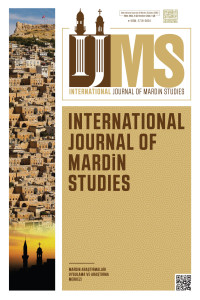Öz
Mardin, Güneydoğu Anadolu Bölgesi’nde geleneksel kent dokusunu korumuş önemli şehirlerdendir. Coğrafi açıdan önemli bir kavşak noktasındaki konumu ile kent, çeşitli uygarlıkların izlerini taşıyan önemli bir kültür birikimine sahip olmuştur. Farklı kültür birikimleri zengin bir mimari kültürün ortaya çıkmasına katkı sağlamıştır. Mardin’de özellikle 19. Yüzyıl ve sonrasında parsel sorununa çözüm olarak üst üste inşa edilmiş evler önemli bir alanı oluşturmaktadır. Mardin evleri, taş malzemeye bağlı olarak şekillenmiş ve kendi içerisinde farklı plan tipolojilerini yansıtmaktadır. Hâkim yapım malzemesi taşın süslemede kullanılması kendine has nitelikler taşıyarak gelenekselleşmiştir. Taşın farklı teknikler kullanılarak işlenmesi, yüzyıl içerisinde sanat anlayışından farklı kalmasını sağlamıştır. Özellikle Osmanlı dönemi sonundaki sosyal hayatın şekillendirdiği ve daha çok yerel etkilerin ağır bastığı beğeni unsurları taş süslemede ön plana çıkarmıştır. Bu dönemde inşa edilmiş evlerin iç ve dış cephelerindeki değişim bu kapsamda önem taşımaktadır. Çalışma Mardin evlerinde taş süslemelerin kullanıldığı alanlardaki zaman içerisindeki değişim ve çeşitliliğini irdelemeyi amaçlamaktadır.
Kaynakça
- Alioğlu, F. (2000). Mardin: Şehir Dokusu ve Evler. istanbul: Türkiye Ekonomik ve Toplumsal Tarih Vakfı.
- Altun, A. (1971). Mardin'de Türk Devri Mimarisi. İstanbul: Gün Matbaaası.
- Çakmakoğlu-Kuru, A. (2020). Türk Mimarisinde Çapraz 'X' Motif ve İkonografisi. MANAS Sosyal Araştırmalar Dergisi C.9 s.4, 2263-2285.
- Çerme, T. (2000). Taşçılık Zanaatı ve Mimarisi ile Mardin Şehri . Tarih ve Toplum , 15-18.
- Göyünç, N. (1991). XIV. Müzyılda Mardin Sancağı . Ankara: Türk Tarih Kurumu.
- Gün, M. (2018). Eski Mardin'deki Türk Devri Mimarisinde Eyvan Kullanımı. Samsun: Ondokuz Mayıs Üniversitesi, Sosyal Bilimler Enstitüsü, Yayınlanmamış Yüksek Lisans Tezi.
- Güvenç, B. (1994). İnsan ve Kültür. İstanbul: Remzi Kitabevi.
- Güzel, G. (2010). Mardin'deki Osmanlı Dönemi Mimari Yapılarda Taş Süsleme. Van : Yüzüncü Yıl Üniversitesi, Sosyal Bilimler Enstitüsü, Yayınlanmamış Yüksek Lisans Tezi.
- Karabulut, İ. H. (2019). Tarihi Mardin Evlerinin Başoda Geleneği. Van: Yüzüncü Yıl Üniversitesi, Yayınlanmamış Yüksek Lisans Tezi.
- Karabulut, İ. H. (2021). Mardin Evlerinde Mihrabiye Formlu İki Niş. Artuklu İnsan Ve Toplum Bilim Dergisi (6)2, 83-104.
- Kaş, S. (2003). Mardin Merkez'de Sivil Mimari Süslemelerinde Tiplojik Çözümleme. İstanbul: Marmara Üniversitesi,Sosyal Bilimler Enstitüsü, Yayımlanmamış Yüksek Lisans Tezi.
- Kılıçaslan, Ü. D. (2015). Mardin'deki Geleneksel Taş İşlemeciliği ve Günümüzdeki Yansımaları. Van: Van Yüzüncü Yıl Üniversitesi, Sosyal Bilimler Enstitürü, Yayımlanmamış Yüksek Lisans Tezi.
- Ögel, S. (1987). Anadolu Selçukları'nın Taş Tezyinatı . Ankara.
- Özbek, Y. (2002). Osmanlı Beyliği Mimarisinde Taş Süsleme (1300-1453). Ankara.
- Sözen , M., & Tanyeli, U. (2011). Sanat Kavram ve Terimler Sözlüğü. İstanbul: Remzi Kitapevi.
- Yeşilbaş, E. (2018). Mardin Çarşılarının Tarihi ve Mimari Özelliklerine Dair Tespitler . Sanat Dergisi , 97-117.
- Yeşilbaş, E. (2020). Ortaçağ İslam Mimarisi Süsleme Programında Kakma Tekniği: Mardin Örneği. Artuklu Akademi 7 (1), 29-76.
Öz
Mardin is on of the important cities in the Southeastern Anatolia Region that has preserved its traditional urban texture. With its location at a geographically important crossroads, the city has has an important cultural accumulation bearing the traces of various civilizations. Different cultural accumulations contributed to be emergence of a rich architectural culture. In Mardin, especially in the 19th centruy and later, the houses built on top of each other as a solution to the parcel problem constitute an important area. Mardin houses; The stone is shaped depending on the material and reflects different plan typologies within itself. The use of stone, wich is the dominant construction material, in decoration has become traditional with ist own characteristics. The processing of the stone using different techniques made in different from the understanding of art throughout yhe centruy. In particular, the elements of taste, which were shaped by the social life at the end of the Ottoman period and dominated by local influences, came to the fore stone decoration. The change in the interior and exterior facedes of the houses built in this period is important in this context. The study aims to examine the change and diversity over time in the areas where stone decorations are used in Mardin houses.
Anahtar Kelimeler
Kaynakça
- Alioğlu, F. (2000). Mardin: Şehir Dokusu ve Evler. istanbul: Türkiye Ekonomik ve Toplumsal Tarih Vakfı.
- Altun, A. (1971). Mardin'de Türk Devri Mimarisi. İstanbul: Gün Matbaaası.
- Çakmakoğlu-Kuru, A. (2020). Türk Mimarisinde Çapraz 'X' Motif ve İkonografisi. MANAS Sosyal Araştırmalar Dergisi C.9 s.4, 2263-2285.
- Çerme, T. (2000). Taşçılık Zanaatı ve Mimarisi ile Mardin Şehri . Tarih ve Toplum , 15-18.
- Göyünç, N. (1991). XIV. Müzyılda Mardin Sancağı . Ankara: Türk Tarih Kurumu.
- Gün, M. (2018). Eski Mardin'deki Türk Devri Mimarisinde Eyvan Kullanımı. Samsun: Ondokuz Mayıs Üniversitesi, Sosyal Bilimler Enstitüsü, Yayınlanmamış Yüksek Lisans Tezi.
- Güvenç, B. (1994). İnsan ve Kültür. İstanbul: Remzi Kitabevi.
- Güzel, G. (2010). Mardin'deki Osmanlı Dönemi Mimari Yapılarda Taş Süsleme. Van : Yüzüncü Yıl Üniversitesi, Sosyal Bilimler Enstitüsü, Yayınlanmamış Yüksek Lisans Tezi.
- Karabulut, İ. H. (2019). Tarihi Mardin Evlerinin Başoda Geleneği. Van: Yüzüncü Yıl Üniversitesi, Yayınlanmamış Yüksek Lisans Tezi.
- Karabulut, İ. H. (2021). Mardin Evlerinde Mihrabiye Formlu İki Niş. Artuklu İnsan Ve Toplum Bilim Dergisi (6)2, 83-104.
- Kaş, S. (2003). Mardin Merkez'de Sivil Mimari Süslemelerinde Tiplojik Çözümleme. İstanbul: Marmara Üniversitesi,Sosyal Bilimler Enstitüsü, Yayımlanmamış Yüksek Lisans Tezi.
- Kılıçaslan, Ü. D. (2015). Mardin'deki Geleneksel Taş İşlemeciliği ve Günümüzdeki Yansımaları. Van: Van Yüzüncü Yıl Üniversitesi, Sosyal Bilimler Enstitürü, Yayımlanmamış Yüksek Lisans Tezi.
- Ögel, S. (1987). Anadolu Selçukları'nın Taş Tezyinatı . Ankara.
- Özbek, Y. (2002). Osmanlı Beyliği Mimarisinde Taş Süsleme (1300-1453). Ankara.
- Sözen , M., & Tanyeli, U. (2011). Sanat Kavram ve Terimler Sözlüğü. İstanbul: Remzi Kitapevi.
- Yeşilbaş, E. (2018). Mardin Çarşılarının Tarihi ve Mimari Özelliklerine Dair Tespitler . Sanat Dergisi , 97-117.
- Yeşilbaş, E. (2020). Ortaçağ İslam Mimarisi Süsleme Programında Kakma Tekniği: Mardin Örneği. Artuklu Akademi 7 (1), 29-76.
Ayrıntılar
| Birincil Dil | Türkçe |
|---|---|
| Bölüm | Araştırma Makaleleri |
| Yazarlar | |
| Yayımlanma Tarihi | 31 Ekim 2022 |
| Yayımlandığı Sayı | Yıl 2022 Cilt: 3 Sayı: 2 |
International Journal of Mardin Studies Creative Commons Atıf-GayriTicari 4.0 Uluslararası Lisansı (CC BY NC) ile lisanslanmıştır.


